
• Boletes are the most known groups of wild edible mushrooms
• Features a meaty texture, a great aroma, and a delicate taste
The most well-known groups of wild mushrooms are boletes (Boletaceae). Edible representatives of this genus are the most delicious mushrooms that have a meaty texture, a great aroma, and a delicate taste.
These fungi feature soft-fleshed caps, central stalk, and pored tubes - reproductive parts under the cap. The tube color ranges from white and yellow to red or green and may bruise to blue, green, or red. Stems are centered and can be smooth, dotted, striated or scabbed. Colors of boletes range from light brown, brown, black to pink, red or yellow.
In the Pacific Northwest, different species of Bolete mushrooms can be found during the spring, summer, and fall seasons. If the weather conditions are favorable, these species grow quickly and in a couple of days become large and beautiful.
Most boletes are mycorrhizal fungi meaning that they build symbiotic relationships with the roots of ectomycorrhizal trees and shrubs.
- King Bolete establishes relationships with conifer trees, primarily with pine, and spruce
- Admirable bolete builds symbiosis with western hemlock and fir
- Aspen Bolete prefers aspen and birch.
There are roughly 300 species of boletes and just a few of them are poisonous or bitter. The good news is that the result of a mistake is not life-threatening but rather can cause gastric upset and diarrhea. Some mushrooms are inedible because of their bitter or sour taste which remains even after cooking. There are methods allowing to identify edible and inedible boletes.
Important:
• Avoid boletes with red or orange pores and flesh that bruises blue or black
• If you aren’t certain, avoid boletes with yellow pores that bruise blue
• If you aren’t absolutely sure it is edible, avoid orange-capped boletes with yellow pores and bruise blue
• Break of a small piece of a mushroom, taste it (do not swallow). If it is bitter or sour, do not take it.
Attention: This technique can be used for boletes only. Absolutely do not use it for other species of mushrooms.
Cautions. Boletes like many other mycorrhizal fungi absorb toxic heavy metals such as lead and neodymium from the soil. Avoid the polluted areas near metal mines, industrial buildings, or busy highways.
Bolete is the safest wild edible mushroom for novices. These mushrooms are easy to identify by their appearance and spongy-like surface underside of the cap.
King Bolete aka Penny Bun, Cep, or Porcini (Excellent Edible)
 King Bolete (Boletus edulis) is highly prized on world markets and, also, the most delicious wild mushrooms. In Italian, it calls Porcini which means “little pig”. This is one of the best edible mushrooms that have a great aroma, texture, and taste. They are excellent for drying, sautéing, or frying. King Bolete is the safest wild edible mushroom for novices.
King Bolete (Boletus edulis) is highly prized on world markets and, also, the most delicious wild mushrooms. In Italian, it calls Porcini which means “little pig”. This is one of the best edible mushrooms that have a great aroma, texture, and taste. They are excellent for drying, sautéing, or frying. King Bolete is the safest wild edible mushroom for novices.
Zeller's Bolete (Excellent Edible)
Zeller's Bolete (Xerocomellus zelleri) is a beautiful medium-sized western bolete with a colorful combination of almost black caps, yellow pores, and red-streaked stalk. The mushrooms are native to the Pacific Northwest and found in the coastal and Cascade Mountains forests under hardwoods and conifers.
Zeller's Bolete is an excellent edible mushroom with a slight odor and delicious taste. Similar to Boletes Edulis, these fungi are great for drying, sautéing, frying, pickling, and freezing.

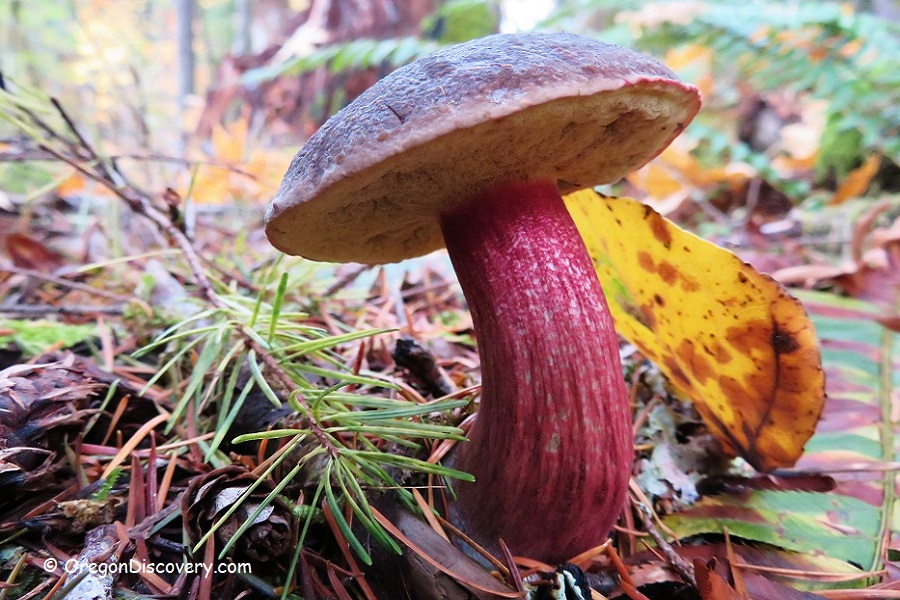
Cap: Rounded, becomes flat when mature. Often wrinkled but not sticky surface, dark-reddish brown to black with reddish margin, 2-4 inches (5-10 cm) wide.
Cap's Underside: Sponge-like, rounded pores, olive-yellow to dark yellow, turning to blue when bruised.
Spore Print: Elliptical, olive-brown.
Stem: Reddish to yellow streaked with red, dry, white, or yellowish at the base, 2-5 inches (4-12 cm) in height.
Flesh: Yellow, red when mature, sometimes staining blue when bruised.
Fruiting: Singly or in small groups.
Habitat: At edges of redwood and conifer forests of the Pacific Northwest.
Season: Fall.
Aspen Bolete (Edible)
Aspen Bolete (Leccinum Insigne) is a great wild edible mushroom that is distinguished by having a red or orange cap and brown scales on its stalk. This fungus can be found on the ground near aspen trees, often fruiting in groups. There are other edible species of Leccinum that resemble Aspen Bolete including Red Aspen Bolete, Manzanita Bolete, and Birch Bolete.
Aspen Bolete mushrooms have an excellent texture, aroma, and taste. When cooked, it becomes darker. Due to reports of some negative effects including gastrointestinal upset, the species need to be cooked well. They are good for drying, pickling, freezing, frying, and sautéing.

Cap: Bun-shaped becoming nearly flat when mature. Dry surface, cap skin is overhanging, bright red to orange-brown when mature, 1.5-6 inches (4-15 cm) wide.
Cap's Underside: Sponge-like, rounded pores are whitish to grayish or olive-brown.
Spore Print: Elliptical, yellow-brown.
Stem: Tall, almost cylindrical, enlarged at base, 3-5 inches (8-15 cm) long.
Flesh: Firm and white, staining gray to black when cut.
Fruiting: Singly or a few together.
Habitat: Mycorrhizal with aspen trees.
Season: June to August.

Bitter Bolete (Inedible)
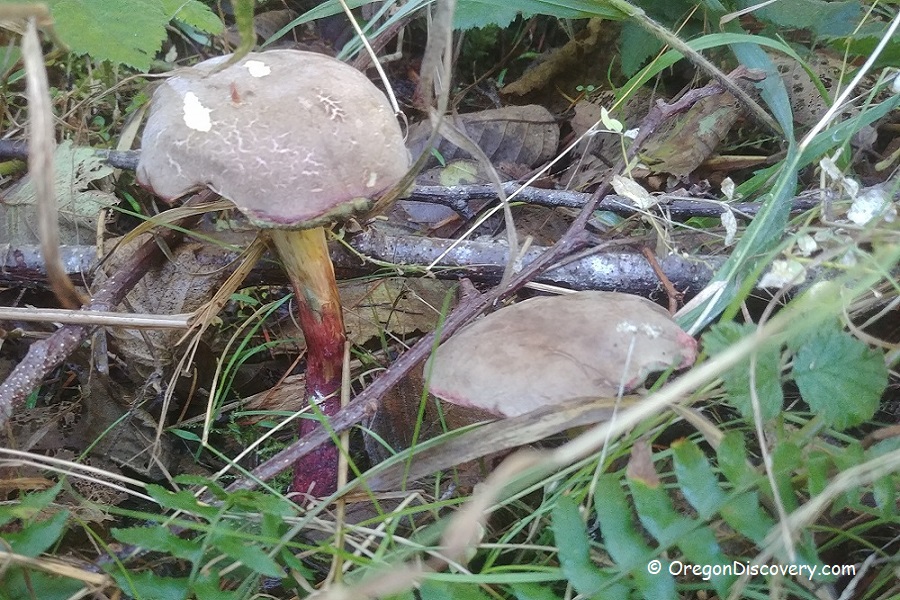

Bitter Bolete (Caloboletus calopus or Caloboletus rubripes), also known as the Red-Stemmed Bitter Bolete or Scarlet-Stemmed bolete is not poisonous but they have a keenly bitter taste that doesn't go away with cooking. Bitter Bolete is distinguished by partly or entirely red stalk. The cap surface is dry, smooth, or cracked. The cap color varies from tan to buff or olive-brown. The underside of the cap has a yellow spongy layer staining blue when bruised. The solid flesh is pale and staining blue when cut or bruised.
Red-Stemmed Bitter Bolete can be found on the ground near conifer trees. Scarlet-Stemmed bolete grows in conifer and deciduous forest.
On the Pacific Northwest, there are other bitter boletes, changing blue when damaged, including Conifer Boletes (Caloboletus conifericola) with yellow to olive-yellow stalk that is enlarged and brown at the base. The cap is yellow-brown to dark-brown, cracking when mature.
You May Also Enjoy
Disclaimer
This is not an official guide to wild mushroom foraging. Please, do your own research, be sure to practice with a mushroom expert before you pick up and consume any wild mushrooms. Before you get started wild mushroom harvesting, learn to accurately identify poisonous mushrooms as well. All wild edible mushrooms must be thoroughly cooked. Make sure that you are not allergic to a new mushroom by trying a small amount before eating more.

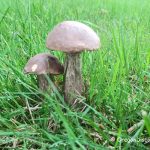
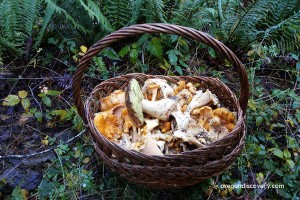

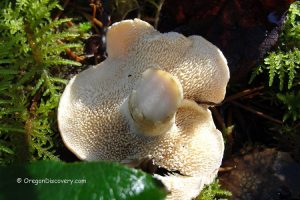
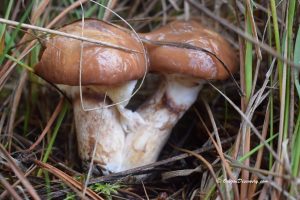
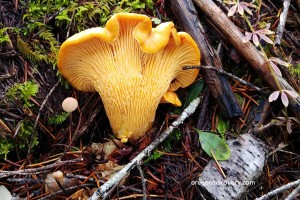
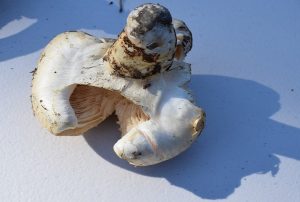
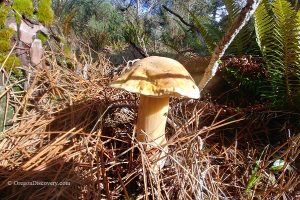
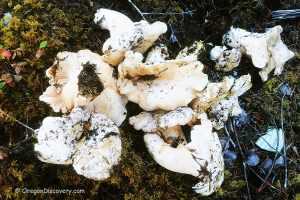

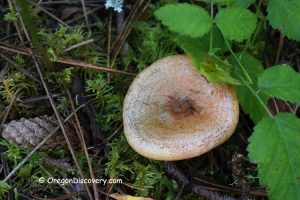
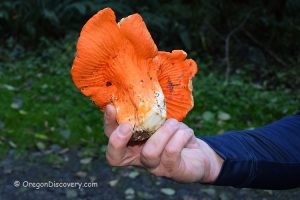
Nice pages!
However you are writing: “Admirable bolete build symbiosis with western hemlock, fir, and red cedar”.
Red Cedar does not have ectomycorrhizal partners, only arbuscular mycorrhizals.
all the best, Daniel
Thank you for your comment.
I’m trying to ID a bolete I saw west of Leavenworth Wa in early August at about 5000 ft elevation. The top had a distinctly pineapple texture, very different than others in the area. 4-6” across, 6” high. I’ve got pictures but can’t attach them here.
Thanks
Mason, I know how much you like mushrooms, so I thought I would send you this information. Good in spaghetti sauce and on pizza. Let me know when you would like to go picking.